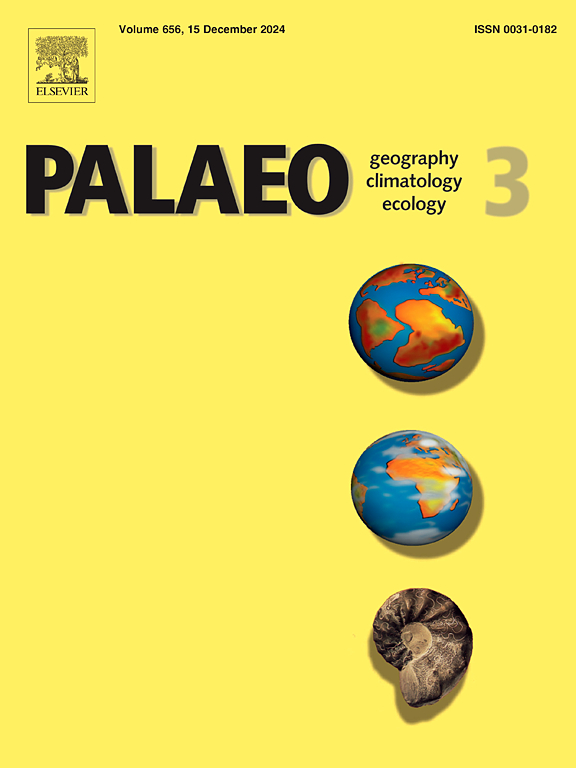Forcing mechanisms of paleosol development at the edge of East Asian Summer Monsoon area over the past 20 kyrs: A large-scale analysis of lacustrine and dune field sedimentary archives in Central China
IF 2.7
2区 地球科学
Q2 GEOGRAPHY, PHYSICAL
Palaeogeography, Palaeoclimatology, Palaeoecology
Pub Date : 2025-07-14
DOI:10.1016/j.palaeo.2025.113137
引用次数: 0
Abstract
Extensive paleosols have intermittently developed across the East Asian Summer Monsoon (EASM) region over the past 20kyrs but climate forcing mechanisms remain uncertain. In this paper, we compile 593 absolute ages of 87 aeolian sand-paleosol profiles from the Hulun Buir (HB), Otindag (OD) and Qinghai Lake (QH) dune field of central China to more accurately understand paleosol development across this region. In addition, paleoclimatic records from Hulun Lake, Dali Lake and Qinghai Lake from within the dune field are quantitatively analyzed to understand the main drivers of paleosol development. Results show that effective moisture was the pacemaker of paleosol development in the OD dune field with peak deveiopment of paleosols in the mid-Holocene (8–3.5 ka). The HB dune field also extensively developed paleosols during the mid-Holocene optimum (9–4 ka), corresponding to strong effective moisture and high lake-level in the Hulun Lake record. Paleosols were widely developed in the QH dune field during the middle to Late Holocene (6–1 ka), which was not correlated with the precipitation and temperature records of the Qinghai Lake alone, but was in phase with the effective moisture records (i.e., high lake-level and Thaumarchaeol content). These results confirm that effective moisture is the main forcing mechanism of paleosol development at the edge of the EASM region. This explains the delay of the mid-Holocene optimum compared to the early Holocene insolation peak, because the increased evaporation caused by the increase in insolation and temperature in the early Holocene may have been sufficient to reduce the effective moisture, resulting in increased regional aeolian activity and dust availability. We also suggest that the correlation between magnetic susceptibility and precipitation in the dune fields in northern China is not a simple linear relationship, but a potential proxy for regional effective moisture. This study is important for understanding the mechanism of paleosol development and related climate dynamic feedbacks in arid and semi-arid regions, as well as for combating land desertification.
近20年东亚夏季风边缘古土壤发育的强迫机制——基于中国中部湖沙场沉积档案的大尺度分析
在过去20年中,东亚夏季风(EASM)地区广泛的古土壤间歇性发育,但气候强迫机制仍不确定。本文通过对呼伦贝尔(HB)、敖廷达(OD)和青海湖(QH)沙丘区87个风成沙-古土壤剖面的593个绝对年龄进行整理,以期更准确地了解该地区古土壤的发育情况。此外,对沙丘区呼伦湖、大理湖和青海湖的古气候记录进行了定量分析,以了解古土壤发育的主要驱动因素。结果表明,有效水分是OD沙丘区古土壤发育的“起跑器”,古土壤发育高峰出现在中全新世(8 ~ 3.5 ka)。在全新世中期(9-4 ka), HB沙丘区古土壤也广泛发育,对应于呼伦湖记录的强有效水分和高湖泊水位。全新世中晚期(6-1 ka)古土壤在QH沙丘区广泛发育,与青海湖的降水和温度记录不单独相关,而与有效水分记录(即高水位和高古酚含量)相一致。这些结果证实了有效水分是东亚东部边缘地区古土壤发育的主要强迫机制。这解释了中全新世最佳日照峰值相对于全新世早期的延迟,因为全新世早期日照和温度的增加导致的蒸发增加可能足以降低有效水分,从而导致区域风成活动和沙尘有效性的增加。研究还表明,中国北方沙丘田磁化率与降水的相关性不是简单的线性关系,而是区域有效湿度的潜在代表。该研究对了解干旱半干旱区古土壤发育机制及其相关的气候动力反馈,以及防治土地沙漠化具有重要意义。
本文章由计算机程序翻译,如有差异,请以英文原文为准。
求助全文
约1分钟内获得全文
求助全文
来源期刊
CiteScore
5.90
自引率
10.00%
发文量
398
审稿时长
3.8 months
期刊介绍:
Palaeogeography, Palaeoclimatology, Palaeoecology is an international medium for the publication of high quality and multidisciplinary, original studies and comprehensive reviews in the field of palaeo-environmental geology. The journal aims at bringing together data with global implications from research in the many different disciplines involved in palaeo-environmental investigations.
By cutting across the boundaries of established sciences, it provides an interdisciplinary forum where issues of general interest can be discussed.

 求助内容:
求助内容: 应助结果提醒方式:
应助结果提醒方式:


